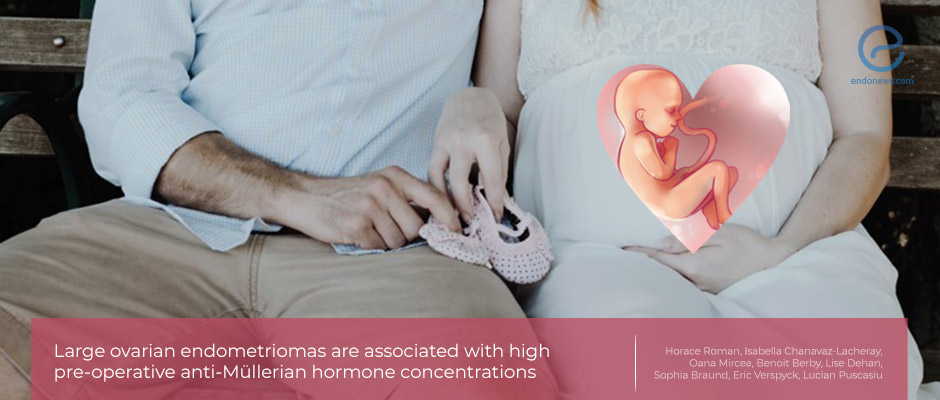Endometrioma size and anti-Müllerian hormone levels
Nov 26, 2020
Preoperative serum anti-Müllerian hormone level is significantly related to the size of endometrioma.
Key Points
Highlights:
- The preoperative anti-Müllerian hormone levels are significantly high in women with endometrioma larger than 6 cm in size, regardless of the woman's age or bilaterality.
Importance:
- In women with endometriosis wishing to conceive after surgery, the ovarian reserve should be evaluated preoperatively by anti-Müllerian hormone levels.
What’s done here?
- This cohort study was conducted in women with endometriosis who were managed by surgical treatment at a university hospital.
- A complete gynecologic examination and MRI were performed during the preoperative evaluation, and if deep endometriosis was diagnosed by MRI, additional imaging was carried out to determine specific localizations of the deep endometriosis lesions.
- Endometriomas were classified by a cut-off size of 6 cm, and when bilateral each was>3cm.
- The surgical method was decided according to the characteristics of the cyst, ovarian reserve, the woman’s postoperative desire to conceive, and her personal preference for the conceptional route.
Key results:
- A total of 2616 women were operated on, and 332 patients met the eligibility. The median anti-Müllerian hormone level was 2.1 ng/ml.
- The large majority of study participants were infertile and nulliparous.
- There were ovarian endometriomas in two-thirds of women, the size exceeded 6 cm in 10.8% of the patients.
- There was a significant relationship between anti-Müllerian hormone level and cyst size and the patient’s age in univariate analysis.
- A significant association was determined between low anti-Müllerian hormone levels when the patient’s age between 36 and 40 years and over 40 years.
- Higher preoperative serum anti-Müllerian hormone level was found in patients having cysts larger than 6 cm in size, after stratification of other variables.
Strengths and Limitations
- The major strength of this study was that data were collected prospectively by a dedicated clinical researcher to minimize the missing data.
- Another strength was the decision of surgery depending on the presence of pain and/or infertility, not affected by anti-Müllerian hormones.
- The retrospective design and absence of a control group could be accepted as the weaknesses of the study.
- Additionally, preoperative anti-Müllerian hormone level was not remeasured in all patients.
Lay Summary
Endometriotic lesions are encountered in different locations in the pelvic cavity, including but not limited to the ovaries, the pouch of Douglas, the ureters, the bladder, and the bowel. Cystic endometriosis lesions located in the ovary are called "endometrioma". Endometriomas have the risk of impairing ovarian reserve, which defines the capacity of the ovaries.
One of the reliable independent markers of ovarian reserve is the anti-Müllerian hormone that is produced by preantral and small antral follicles. Knowing the level of preoperative anti-Müllerian hormone level is important to decide the surgical procedure, especially in women considering post-operative conception.
Roman and his colleagues from France, Denmark, and Romania, published the study titled “Large ovarian endometriomas are associated with high pre-operative anti-Müllerian hormone concentrations” in the journal "Reproductive BioMedicine Online". The authors aimed to assess the association between preoperative serum anti-Müllerian levels, age, and the presence and size of endometriomas.
The authors stratified the study population according to the size of endometrioma depending on the largest diameter of the cyst, the cut-off value being 6 cm. The size of cysts exceeded 6 cm in 10.8% of the patients.
Univariate analysis showed a significant relationship between anti-Müllerian hormone level, and the cyst size, and the patient’s age. A significant association was found between low serum anti-Müllerian hormone levels and the patient’s age between 36 and 40 years and over 40 years. Higher preoperative serum anti-Müllerian hormone level was found in patients having cysts larger than 6 cm in size, regardless of age or bilaterality. This information is important in women who intend conception following endometriosis surgery. They should be counseled about the impact of endometriosis surgery on the ovarian reserve. This information is also helpful for the surgeons in deciding the best surgical procedure.
“Preoperative anti-Müllerian hormone concentration was significantly increased in women with large endometriomas of over 6 cm, independent of their age or the presence of bilaterality. This is relevant for both surgeons and patients when planning surgery in women with an intention to conceive post-operatively.” the authors added.
Research Source: https://pubmed.ncbi.nlm.nih.gov/33060013/
anti-Müllerian hormone endometriosis ovarian reserve infertility laparoscopy assisted reproductive technology in-vitro fertilization

